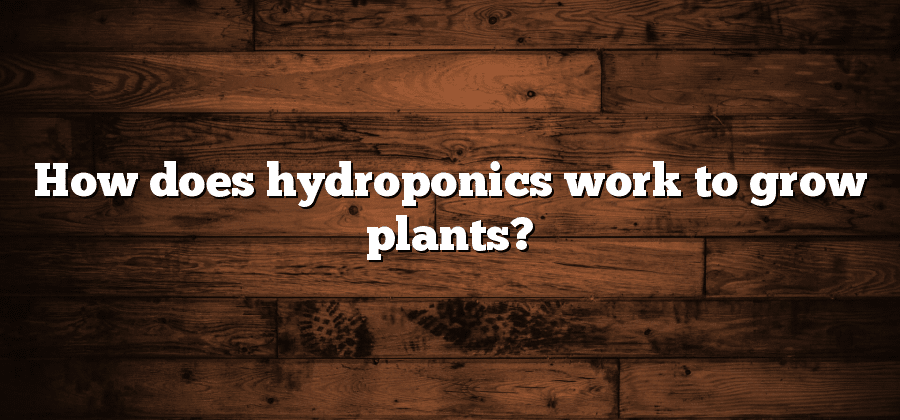What is Hydroponics and its Benefits in Plant Growth?
Hydroponics is a method of growing plants without soil, where the plants receive all their necessary nutrients directly from water solutions. This innovative technique has gained popularity in recent years due to its numerous benefits in plant growth. One significant advantage of hydroponics is its ability to provide optimal conditions for plant growth, allowing faster and healthier development. By eliminating the need for soil, hydroponics enables the plants to have direct access to all the necessary nutrients, resulting in increased growth rates and higher yields. Additionally, the controlled environment in hydroponics systems allows for precise management of factors such as temperature, light, and pH, further enhancing plant growth.
Furthermore, hydroponics offers a solution to some of the limitations imposed by traditional soil-based agriculture. In areas with poor soil quality or contaminated land, hydroponics provides a viable alternative for cultivating plants. Its efficiency in using water is another benefit, as hydroponics requires significantly less water compared to traditional farming methods. This makes it particularly useful in regions facing water scarcity or for those aiming to conserve this precious resource. Moreover, since hydroponics eliminates the need for chemical fertilizers and pesticides commonly used in conventional agriculture, it promotes more sustainable and environmentally friendly growing practices.
History of Hydroponics and its Evolution in Modern Agriculture
Hydroponics, the cultivation of plants without soil, has been practiced for centuries. The history of hydroponics dates back to the ancient civilizations of Babylon and the Hanging Gardens of Babylon, where plants were grown using hydroponic principles. However, it was not until the 19th century that the modern concept of hydroponics started to take shape.
In the 1930s, researchers discovered that plants could be grown using nutrient solutions instead of soil. This breakthrough led to the development of nutrient film technique (NFT) and other forms of hydroponic systems. With advancements in technology and scientific knowledge, hydroponics has evolved to become a viable option for agriculture in modern times. Today, hydroponics is being used in commercial greenhouses, vertical farms, and even space exploration, offering a sustainable and efficient way to grow crops in various environments.
The Basic Principles of Hydroponics
Hydroponics is a method of growing plants without soil, where the plants are instead supported by a nutrient-rich solution. This innovative technique is based on a few fundamental principles that enable plants to thrive and flourish. By understanding these principles, growers can create optimized conditions for plant growth and maximize their yields.
One of the key principles of hydroponics is the provision of a balanced nutrient solution. Instead of drawing nutrients from the soil like in traditional farming, hydroponic plants receive their nourishment directly from the nutrient solution. This solution contains a carefully calibrated mix of essential elements, such as nitrogen, potassium, phosphorus, and micronutrients, to meet the specific needs of each plant. By providing a well-balanced and readily available nutrient solution, hydroponic systems ensure that plants can access the nutrients they require for optimal growth.
Understanding the Importance of Nutrient Solutions in Hydroponics
Hydroponics, a method of growing plants without soil, is gaining popularity in modern agriculture due to its numerous benefits. One of the key factors that contribute to the success of hydroponic systems is the use of nutrient solutions. These solutions are essential for providing plants with the necessary nutrients, as they replace the function of soil in traditional farming methods.
In hydroponics, nutrient solutions are carefully formulated to ensure that plants receive the right balance of essential elements. These solutions consist of a combination of minerals, such as nitrogen, phosphorus, and potassium, along with trace elements like iron, manganese, and zinc. By delivering these nutrients directly to the plant’s roots, hydroponic systems eliminate the need for soil as a medium for nutrient absorption. This allows for precise control over the plant’s nutritional intake, leading to faster growth, higher yields, and healthier plants overall.
In addition, nutrient solutions in hydroponics can be adjusted and tailored to meet the specific requirements of different plant species or growth stages. This level of customization enables growers to optimize nutrient delivery based on factors like pH levels, water temperature, and nutrient concentration. As a result, plants can reach their full potential, regardless of environmental conditions or seasonality. In the following paragraphs, we will explore the different components of nutrient solutions and how they contribute to plant growth in hydroponic systems.
Different Types of Hydroponic Systems and their Functionality
Hydroponics is a highly efficient method of growing plants without the need for soil. It utilizes different types of hydroponic systems that offer unique functionalities to accommodate various plant needs. One common type is the nutrient film technique (NFT) system. In this system, a thin film of nutrient solution continuously flows over the roots of the plants, allowing them to absorb the necessary nutrients. This constant flow of nutrient solution helps in preventing water stagnation and oxygenation of the roots, ensuring optimal plant growth. NFT systems are ideal for growing leafy greens and herbs, as they require less growing media and have a relatively low cost of operation.
Another popular hydroponic system is the deep water culture (DWC) system. In DWC systems, plants are suspended in a nutrient-rich water solution, with their roots directly exposed to this solution. The constant supply of oxygen through the use of air stones or diffusers helps in stimulating root growth and nutrient absorption. DWC systems are particularly suitable for growing larger plants such as tomatoes and cucumbers, as they provide ample space for the roots to expand and support the weight of the plants. Additionally, the simplicity of this system makes it beginner-friendly and easy to maintain.






